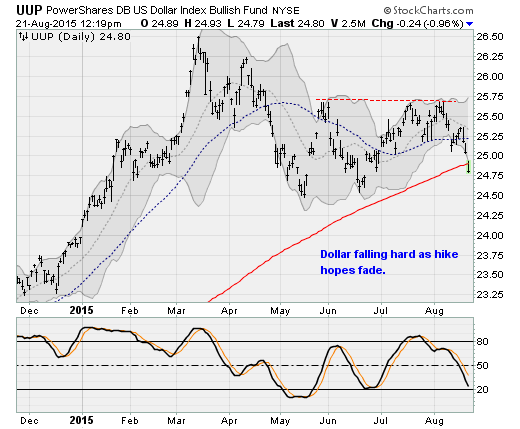Fed hike in question amid global-market turmoil
For the first time in years, global markets are badly shaken.
The S&P 500 (SPX) tallied its worst week since 2011 as it broke a four-year uptrend, returning to levels not seen since October. The 2,000 level that held the index through multiple selloff attempts over the last 11 months has been broken for a loss of more than 7 percent from its May high.
Globally, the Shanghai Composite lost its 200-day moving average -- a critical measure of the long-term trend -- despite authorities vigorously defending the line in the sand since early July. Crude oil dropped below the $40-a-barrel level on Friday for the first time since March 2009. Bourses from Japan to Germany all wilted. Treasury bonds and precious metals have been on the rise as investors sought safe havens. And currencies of emerging-market countries from Vietnam to Kazakhstan are under pressure.
The PowerShares U.S. Dollar Bullish Fund (UUP) lost its 200-day average for the first time since last summer. The yen and the euro are rising, despite aggressive stimulus efforts by the Bank of Japan and the European Central Bank, as popular currency "carry trades" are slammed.
There's been a multi-month decline in market breadth, as fewer and fewer U.S. stocks participated to the upside. Corporate profitability has been pressured by slowdowns overseas, the stronger dollar, a tightening job market and lower energy prices. China has seen a marked slowdown in its economic data, suffered a 32 percent stock-market decline, and unexpectedly devalued its currency last week. Greece is back in the news as Prime Minister Alexis Tsipras stepped down ahead of snap elections. And tensions are building on the Korean peninsula as North and South Korea exchange artillery fire.
Another underlying factor is concerns surrounding the approach of a potential Federal Reserve interest rate hike in September. We're in the midst of "hike havoc" -- not unlike the "taper tantrum" of early 2013 as then Fed Chairman Ben Bernanke considered the beginning of the end of the stimulus program of Fed bond purchases known as quantitative easing.
On Wednesday, the Fed released minutes from its last policy meeting. Traders seem concerned the central bank could be mulling a rate hike despite a lack of progress on pushing inflation back to its 2 percent target.
The reason? This statement: "Many participants indicated that their outlook for sustained economic growth and further improvement in labor markets was key in supporting their expectation that inflation would move up to the Committee's 2 percent objective."
The big question is: Will the Fed ignore the market turmoil or be pressured into waiting? The Fed seems to be tilting towards an earlier rate liftoff with a pause afterwards (the "one and done" scenario for 2015). Fed Chair Janet Yellen has tried, unsuccessfully, to play down the importance of liftoff timing and has said that wage growth and inflation aren't a precondition for the initial rate hike.
But the last time the Fed faced a cliffhanger decision, it blinked.
Bernanke delivered a surprise "no taper" decision at the September 2013 policy meeting, postponing the taper until December, just three months before Yellen began her term.
Will she fold too? The drop in the dollar suggests currency traders believe she will. Yet the selloff in pretty much everything else suggests that in addition to global growth concerns, there's a nagging fear that the world's most important central banker is about to turn hawkish. The Fed could focus on steady job gains and stable economic growth while ignoring a stock market that could be on its way to its first normal and healthy 10 percent correction since 2012.
According to Oxford Economics, the U.S. economy is growing at a 3 percent annual rate. Capital Economics believes the Fed has set a "pretty low bar for rate hike" and with GDP growth likely to be higher than the Fed's June projection they not only "think that the Fed will raise rates in September, but there would appear to be a good chance of a second hike in December as well."
They are looking for second-quarter GDP to be revised up next week to 3.2 percent from 2.3 percent originally, thanks to inventories, consumption and public investment. Gains in personal spending and durable goods orders in July also serve to bolster expectations for third-quarter growth. And a rebound in new home sales in July suggests the housing market is still looking good.
Much depends on the strength of the August jobs report on Sept. 4 -- the last before Yellen's fateful decision.

